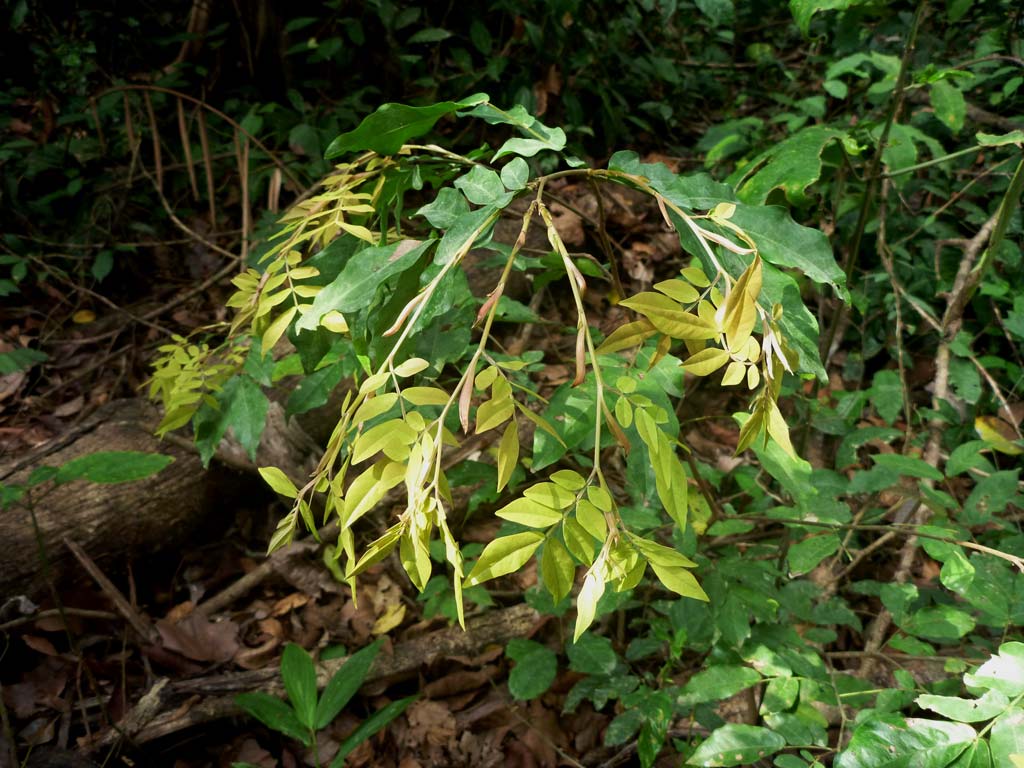|
Common Names: Okwen, Agunri, Eku, Achi
Local Names: Okwen (Edo, Nigeria), Agunri, Eku (Yoruba, Nigeria),
Achi (Igbo, Nigeria)
Species ID: NMP-264 | wfo-0000213937 | NCBI_Taxonomy ID:
2879473
Scientific
Classification
Kingdom: Plantae
Clade: Tracheophytes
Clade: Angiosperms
Clade: Eudicots
Clade: Rosids
Order: Fabales
Family: Fabaceae
Genus: Brachystegia
Species: B. nigerica
Authority: Hoyle & A.P.D. Jones
Synonyms: None widely documented in current taxonomic literature
(Plants of the World Online).
Morphological Description
- Habit: Large evergreen tree, typically 20–36 m tall,
with a straight bole and a dense, spreading crown forming part of the
upper rainforest canopy (Burkill, 1985; IITA Forest Center, 2017).
- Bark: Grey to dark brown, rough and fissured, often
peeling in strips; inner bark fibrous and used locally for minor
construction and fuel (Burkill, 1985).
- Leaves: Pinnate leaves bearing 4–8 pairs of elliptic to
oblong leaflets (3–8 cm long), glossy green; young flushes often reddish,
a common feature in Brachystegia species (Fern, 2024).
- Flowers: Small, creamy-white to pale pink, produced in
terminal or axillary panicles; flowers are nectar-bearing and attract a
range of insect pollinators (Prance & Jongkind, 2015).
- Fruit: Large, purplish-brown to black, oblong flat pods
(about 15–25 cm long) containing on average 3–5 dark-brown, disc-shaped
seeds; pods dehisce explosively, flinging seeds away from the parent tree
(IITA Forest Center, 2017; Kew Science, n.d.).
- Seeds: Recalcitrant seeds, sensitive to drying;
germination occurs in about 14–21 days with 55–60% germination under
nursery conditions (IITA Forest Center, 2017).
- Geographic Range: Considered endemic to wetter areas of forest in
southern Nigeria, where trees may be abundant in small, localized
populations (IITA Forest Center, 2017; Kew Science, n.d.). Some secondary
reports suggest occurrences in Cameroon, Ghana, and Ivory Coast, but these
may partly reflect confusion with related Brachystegia species (Oti,
2016).
- Habitat: High wet evergreen forest, often along streams,
river banks, valley bottoms and lower slopes; prefers deep, well-drained,
loamy soils with annual rainfall of roughly 1,500–2,500 mm (Fern, 2024;
IITA Forest Center, 2017).
- Elevation: Mostly at low elevations, generally up to about
500 m above sea level (Fern, 2024).
- Conservation Status: Listed as Vulnerable (VU) at regional level due
to deforestation, agricultural expansion, and habitat fragmentation in
southern Nigeria (IITA Forest Center, 2017).
- Ecological Role: Acts as a dominant canopy species in fragments of
moist forest, providing shade and habitat for epiphytes, birds, and
arboreal mammals; explosive pod dehiscence contributes to local seed rain
patterns (Burkill, 1985).
Ethnobotanical
compilations on Nigerian forest trees note that bark and leaves of Brachystegia
species are sometimes incorporated into remedies for gastrointestinal
complaints and minor wounds, mainly on account of their astringent bark and
tannin content, although specific recipes are rarely attributed unambiguously
to B. nigerica (Burkill, 1985). At present there are no peer-reviewed
pharmacological studies conducted directly on bark or leaf extracts of B.
nigerica.
- Culinary and Nutritional
Support: In south-eastern Nigeria,
seeds of Brachystegia nigerica are among the indigenous soup thickeners used
daily, alongside Afzelia africana and Mucuna sloanei; they are ground into
flour and added to soups for viscosity and satiety (Oti, 2016). These
traditional thickeners accompany carbohydrate staples and are important
protein and energy sources in rural diets.
- General Health Tonic: Because seed flours provide appreciable protein,
fat and minerals, they are often recommended locally for convalescents and
individuals requiring weight gain or improved strength.
- Putative Antioxidant and
Anti-inflammatory Potential (Indirect Evidence): Experimental work on closely related
soup-thickener seeds (for example Brachystegia eurycoma and Detarium
microcarpum) has shown notable antioxidant capacity, phenolic content, and
anti-inflammatory activity in rodent models, mediated by flavonoids and
phenolic acids.
Toxicity Profile: No acute or chronic toxicity studies have yet
been published specifically for Brachystegia nigerica. In the absence of
dedicated toxicological studies, the use of large medicinal doses of bark, leaves
or seed extracts is not recommended, especially in pregnancy, lactation, or in
young children. People with chronic liver or kidney disease should be cautious
until more specific data are available.
- Timber: The wood of Brachystegia nigerica is used locally
for furniture, interior joinery, parquet flooring and general
construction. It is valued for its good mechanical properties, though it
can be susceptible to termite attack if not properly treated( Burkill,
1985).
- Fuelwood and Charcoal: Bark and stem wood are harvested for firewood and
charcoal production in rural communities, reflecting the tree’s high
calorific value (Burkill, 1985).
- Agroforestry and Ecology: As a large, shade-casting tree, B. nigerica helps
to stabilize soils, buffer microclimates and provide habitat for
understory crops and forest fauna. Wildlings are often found along forest
trails where parent trees occur, indicating good regeneration potential
under partial canopy openings (IITA Forest Center, 2017).
- Cultural Uses: In some Nigerian communities, bark and leaves
from Brachystegia species are incorporated into rituals linked with
protection and cleansing, although species-level details are often not
specified in the literature (Burkill, 1985).
- Burkill, H. M.
(1985). The useful plants of West Tropical Africa (Vol. 1). Royal Botanic Gardens, Kew.
- Fern, K. (2024).
Brachystegia nigerica. In Useful Tropical Plants Database. Retrieved from
https://tropical.theferns.info/viewtropical.php?id=Brachystegia+nigerica
- International Institute
of Tropical Agriculture (IITA). (2017). Brachystegia nigerica
Hoyle & A.P.D. Jones (species
factsheet). IITA Forest Center, Nigeria.
- Kew Science.
(n.d.). Brachystegia nigerica Hoyle & A.P.D. Jones. Plants of the World Online. Retrieved
from https://powo.science.kew.org/taxon/urn:lsid:ipni.org:names:482242-1
- Lykke, A. M., et al.
(2019). Carbohydrates, proteins, fats and selected minerals in seeds from wild
edible plants in Nigeria. Heliyon, 5(3), e01310.
- Oti, W. J. O. (2016).
Levels of heavy metals in some soup thickeners used in Aboemge in Ebonyi State,
Nigeria. IOSR Journal of Pharmacy and Biological Sciences, 11(3), 45–47.
- Prance, G. T., &
Jongkind, C. C. H. (2015). Fabaceae. In Flora of West Tropical
Africa. Royal Botanic Gardens,
Kew.
|
